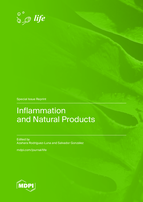Inflammation and Natural Products
A special issue of Life (ISSN 2075-1729). This special issue belongs to the section "Pharmaceutical Science".
Deadline for manuscript submissions: closed (30 May 2023) | Viewed by 39456
Special Issue Editors
Interests: inflammation; natural products; skin pathologies; photoprotection; microalgae; polyphenols; carotenoids
Special Issues, Collections and Topics in MDPI journals
Interests: skin; photoprotection; skin cancer; inflammation; natural products; confocal microscopy
Special Issues, Collections and Topics in MDPI journals
Special Issue Information
Dear Colleagues,
Terrestrial and marine environments are inexhaustible sources of compounds and active extracts, which have been employed in medicine since ancient times. The aim of this Special Issue is to collect new approaches around compounds and extracts isolated from natural products and their biological activity, with a focus on anti-inflammatory pathways. Thus, this Special Issue welcomes full papers, short communications, and review articles on natural (from terrestrial or marine sources) secondary metabolites of microorganisms and plants which have significant anti-inflammatory activity.
This Special Issue will serve as a reference text for researchers and academics, as well as those studying natural products and their pharmacological activities. Researchers working in the field of natural products and related pathways are encouraged to publish their recent findings in this Special Issue of Life.
Dr. Azahara Rodríguez-Luna
Dr. Salvador González
Guest Editors
Manuscript Submission Information
Manuscripts should be submitted online at www.mdpi.com by registering and logging in to this website. Once you are registered, click here to go to the submission form. Manuscripts can be submitted until the deadline. All submissions that pass pre-check are peer-reviewed. Accepted papers will be published continuously in the journal (as soon as accepted) and will be listed together on the special issue website. Research articles, review articles as well as short communications are invited. For planned papers, a title and short abstract (about 100 words) can be sent to the Editorial Office for announcement on this website.
Submitted manuscripts should not have been published previously, nor be under consideration for publication elsewhere (except conference proceedings papers). All manuscripts are thoroughly refereed through a single-blind peer-review process. A guide for authors and other relevant information for submission of manuscripts is available on the Instructions for Authors page. Life is an international peer-reviewed open access monthly journal published by MDPI.
Please visit the Instructions for Authors page before submitting a manuscript. The Article Processing Charge (APC) for publication in this open access journal is 2600 CHF (Swiss Francs). Submitted papers should be well formatted and use good English. Authors may use MDPI's English editing service prior to publication or during author revisions.
Keywords
- natural products
- inflammation
- biological activity
- anti-inflammatory activity
- antioxidant activity
- anticancer potential
- terrestrial products
- marine products
- phytochemistry
- pharmacology








